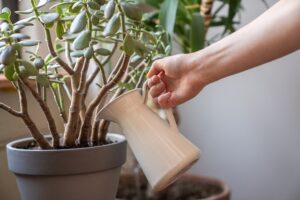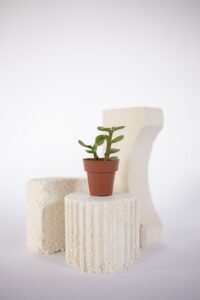Many of us love to grow succulents in our house premises and office spaces because they are considered a symbol of good luck. Here, we are going to unveil insights into Jade plant care in detail.
An overview of the Jade Plant
The Jade plant Crassula argentea belongs to the family Crassulaceae. This plant is native to South Africa. Jade plants are succulent houseplants with fleshy, oval-shaped leaves and woody stems. These plants may grow many years without blooming, and it takes more years to bloom. Typically, they grow from 2 to 5 feet in height, and of course, they are slow growers.
Jade plant care In Indoor at a glance!

Indoor plants contribute to making the home environment pleasant. They need a humid atmosphere and plenty of light.
Sunlight
Typically Jade plants love the sunlight. Younger plants especially require more light than mature plants. According to the latest research findings, Jade plants need 6 to 8 hours of sunshine daily.
Do not forget that too much light will result in scorching immature plants. According to the research that Purdue University has done, Jade plants have the potential to adapt to medium to high light conditions.
You can track whether your Jade plant receives strong and direct sunlight by checking the leaves of the plant carefully.
When the plant receives strong and direct sunlight, the leaves develop red-colored edges around the leave. There is nothing to worry about regarding this; it simply means that you have a healthy Jade plant.
So, you can keep your Jade plants closer to the window, or else you can provide artificial light.
When these plants lack enough light, their leaves will become yellow and die.
Water
You must think about the water supply when you keep Jade plants indoors. That is because these plants need well-drained soil. If the soil is wetter, do not water it.
Make sure to water your Jade plants during spring and summer very often. But you have to think twice before watering them during the Winter. Water requirements during the Winter totally depend on the plant as these plants can store water.
Temperature
The temperature should be 60 to 70 Farenhite at night and in Winter. They can grow in 55 Farenhites, but Jade plants are unable to survive in 50 Faranhites temerature.
Important tip:
According to the recomemndation of most Agriculture Institutes, if you can apply controlled-release fertilizer or liquid fertilizer or compost at the beginning of the season will benefit Jade plants.
However, if you provide optimal care, you will be gifted a stunning Jade plant.
How To Care Jade Plant In Winter?
Even though Jade plants love sunlight, we can even grow them in Winter successfully.
Here is how to take care of Jade plants in Winter.
There, you have to provide warm conditions for the Jade plants. You can easily place your plant closer to the windows. But do not forget to turn the plant time-to-time to get better light. Consequently, you can protect the plant from being stunted and leggy. Also, you can use bulbs (LED bulbs) to provide artificial light.
Jade plants become dormant during the Winter period. Do not water them when the soil is wet. That is because surface soil should be completely dried before watering them in Winter. If plants have shriveled leaves, it means that plants need water. Also, fertilize them once a month.
Never prune Jade plants in Winter. Pruning should be done in early Winter or Spring and Summer.

How To Care Jade Plant In Rainy Seasons?
Research findings emphasize that bringing your jade plant inside during the rainy season is wiser. Consequently, you can keep your plant safe from excessive rainwater.
But are you worried about light?
We have pretty good news regarding the requirement for light.
You can grow Jade plants for a week without direct light.
But if the rainy season goes on for weeks, you should have to provide artificial light. Another thing that we need to emphasize here is that there is no need for much water during the rainy season.
Important:
Make sure to water the soil, not leaves or stems, because it can cause the growth of mold and root rots.
If you are digging up for more information, you can read about the irrigation & fertilizer practices for Jade plants.
Keeping plants indoors is the best way to care for Jade plants in the rainy season.
Jade plant care in outdoor- Tested tips & tricks
If you are interested in growing Jade plants outdoors, you should have a great idea about it.
So, here we are going to unveil a few tips that we have discovered throughout the past few years.
You can use different pots that have different sizes and shapes. Leaves or stem cuttings can do propagation of the Jade plant.
But, propagation should be done during summer or spring. Winter is not suitable for propagating process.
Expose your Jade plant to bright sunlight for up to 4 to 6 hours per day and water twice daily. If it is a sunny day, add more. Keep in your mind thoroughly that growing Jade plants outdoors requires well-drained soil.
Although the Jade plant is succulent and drought tolerant, there are a few associated issues.
If these plants do not have enough water supply, you will come up with shriveled leaves. If Jade plants do not receive enough sunlight, it shows loss of leaves or leggy.
If you take good care of your plants, you will have a healthy and well-grown Jade plant in your yard.
Gollum Jade Plant Care
Gollum Jade are succulent plants that have finger-like leaves. If you carefully check them out, you will see a pink color spot at the top of the leaves. Gollum Jade plants typically grow up to 2 to 3 feet.
Cut off watering in Winter and rainy seasons. They need plenty of direct light for up to 3 to 5 hours. In Winter and rainy times, you should grow them indoors or under the shade. Feeding should be done in summer and lightly in spring. Propagation should be done in summer or spring.
Growing Gollum Jade plants need less care and effort compared to others.
The Bottom Line
You should keep in mind knowing management practices, requirements, and cultural methods are the best substitute for a green thumb. Although you enjoy growing Jade plants, many parts of Jade plants are toxic to your loving pets.

